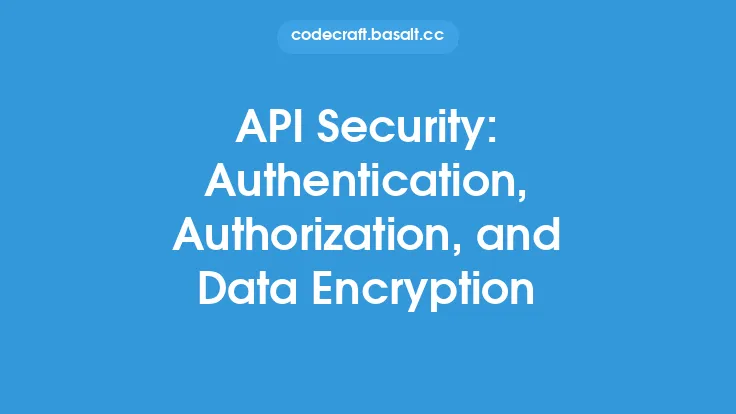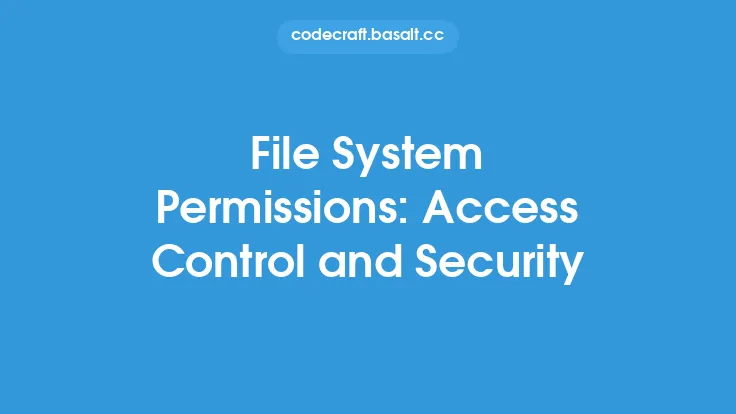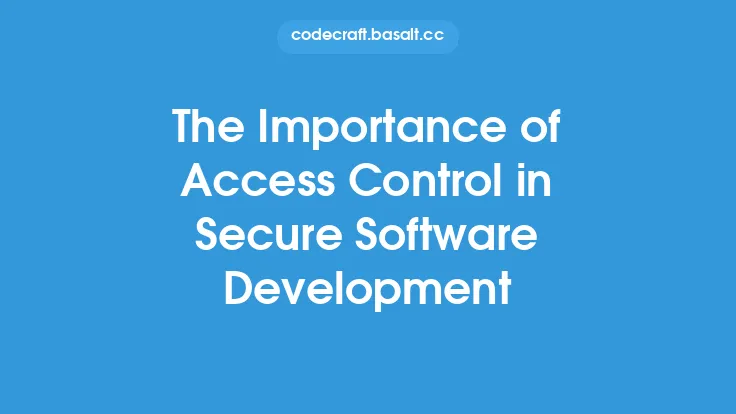Access control and authorization are fundamental concepts in the realm of cybersecurity, playing a crucial role in protecting computer systems, networks, and data from unauthorized access and malicious activities. At its core, access control refers to the process of granting or denying access to resources, systems, or data based on a set of predefined rules, policies, and procedures. Authorization, on the other hand, is the process of determining whether a user or entity has the necessary permissions or privileges to access a particular resource or perform a specific action.
Introduction to Access Control
Access control is a broad term that encompasses various mechanisms, techniques, and technologies designed to regulate and manage access to sensitive resources, systems, and data. The primary goal of access control is to prevent unauthorized access, use, disclosure, disruption, modification, or destruction of computer systems, networks, and data. Access control can be applied to various aspects of cybersecurity, including physical access control, network access control, and application access control. Physical access control refers to the measures taken to prevent unauthorized physical access to computer systems, networks, and data storage devices. Network access control, on the other hand, focuses on regulating access to computer networks, including the internet, local area networks (LANs), and wide area networks (WANs). Application access control, as the name suggests, is concerned with controlling access to specific applications, services, or resources.
Authorization: The Process of Granting Access
Authorization is an essential component of access control, as it determines whether a user or entity has the necessary permissions or privileges to access a particular resource or perform a specific action. The authorization process typically involves several steps, including authentication, policy evaluation, and access decision. Authentication is the process of verifying the identity of a user or entity, typically through the use of credentials such as usernames, passwords, or biometric data. Policy evaluation involves analyzing the access control policies and rules to determine whether the authenticated user or entity has the necessary permissions or privileges to access the requested resource. The access decision is then made based on the outcome of the policy evaluation, either granting or denying access to the resource.
Key Concepts in Access Control and Authorization
Several key concepts are essential to understanding access control and authorization, including identity, authentication, authorization, and auditing. Identity refers to the unique characteristics or attributes that define a user or entity, such as usernames, passwords, or biometric data. Authentication, as mentioned earlier, is the process of verifying the identity of a user or entity. Authorization, as discussed earlier, is the process of determining whether a user or entity has the necessary permissions or privileges to access a particular resource or perform a specific action. Auditing, on the other hand, refers to the process of monitoring and logging access control events, including successful and unsuccessful access attempts, to detect and respond to potential security incidents.
Access Control Models and Mechanisms
Several access control models and mechanisms are used to implement access control and authorization, including access control lists (ACLs), role-based access control (RBAC), and attribute-based access control (ABAC). Access control lists (ACLs) are a simple and widely used access control mechanism that involves assigning permissions or privileges to users or groups based on a set of predefined rules. Role-based access control (RBAC) is a more advanced access control model that involves assigning permissions or privileges to users based on their roles or responsibilities within an organization. Attribute-based access control (ABAC) is a more fine-grained access control model that involves assigning permissions or privileges to users based on a set of attributes or characteristics, such as department, job function, or security clearance.
Best Practices for Implementing Access Control and Authorization
Implementing access control and authorization requires careful planning, design, and implementation to ensure the security and integrity of computer systems, networks, and data. Several best practices can be followed to ensure effective access control and authorization, including implementing least privilege access, separating duties, and regularly reviewing and updating access control policies and rules. Least privilege access involves granting users only the necessary permissions or privileges to perform their jobs, reducing the risk of unauthorized access or malicious activities. Separating duties involves dividing tasks and responsibilities among multiple users or entities to prevent a single user or entity from having too much power or control. Regularly reviewing and updating access control policies and rules is essential to ensure that access control remains effective and aligned with changing business needs and security requirements.
Common Challenges and Limitations
Access control and authorization are not without challenges and limitations, including the complexity of access control policies and rules, the difficulty of managing access control across multiple systems and platforms, and the risk of access control breaches or vulnerabilities. The complexity of access control policies and rules can make it difficult to manage and maintain access control, particularly in large and complex organizations. Managing access control across multiple systems and platforms can be challenging, particularly when different systems and platforms have different access control mechanisms and protocols. Access control breaches or vulnerabilities can occur due to various reasons, including weak passwords, inadequate access control policies, or vulnerabilities in access control mechanisms.
Conclusion and Future Directions
In conclusion, access control and authorization are critical components of cybersecurity, playing a vital role in protecting computer systems, networks, and data from unauthorized access and malicious activities. Understanding the key concepts, models, and mechanisms of access control and authorization is essential for implementing effective access control and ensuring the security and integrity of computer systems, networks, and data. As technology continues to evolve and cybersecurity threats become more sophisticated, it is essential to stay up-to-date with the latest developments and best practices in access control and authorization to ensure the security and integrity of computer systems, networks, and data. Future directions in access control and authorization may include the development of more advanced access control models and mechanisms, such as artificial intelligence and machine learning-based access control, and the increased use of cloud-based access control and authorization solutions.





